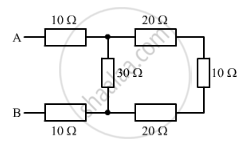Advertisements
Advertisements
Question

Solution
The resistors of values 20 Ω, 10 Ω and 20 Ω are connected in series. Therefore, their net resistance is:
R = 20 Ω + 10 Ω + 20 Ω
R = 50 Ω
This combination of resistors are connected in parallel with that of value 30 Ω. Therefore, the resistance R' is:
1/R' = (1/50) + (1/30)
1/R' = (3 + 5)/150
R' = 150/8
R' = 18.75 Ω
The resistance, R' is connected in series with the two resistors of values 10 Ω each. Hence, the total resistance between A and B is:
18.75 + 10 + 10 = 38.75 Ω
APPEARS IN
RELATED QUESTIONS
Judge the equivalent resistance when the following are connected in parallel − (a) 1 Ω and 106Ω, (b) 1 Ω and 103Ω and 106Ω.
The substance having infinitely high electrical resistance is called:
(a) conductor
(b) resistor
(c) superconductor
(d) insulator
If the length of a wire is doubled by taking more of wire, what happens to its resistance?
A p.d. of 4 V is applied to two resistors of 6 Ω and 2 Ω connected in series. Calculate:
(a) the combined resistance
(b) the current flowing
(c) the p.d. across the 6 Ω resistor
What potential difference is needed to drive a current o f 1 A through a 5 Ω resistor?
Choose the correct alternative and rewrite the following sentence.
If three resistors 2 ohms, 3 ohms and 4 ohms are connected in series, then the effective resistance in the circuit will be _______ ohms.
Write an expression for the resistance of a conducting wire in terms of its length and area of cross-section.
You are provided with three resistors of resistance 1.0 Ω, 2.0 Ω and 3.0 Ω How would you connect them to obtain the total effective resistance 1.5 Ω? Draw diagram of the arrangement and check it by calculations.
What should be the length of a nickel wire of area of cross-section 3 mm2 used for making a rheostat of 750 ohm? (ρ of nickle = 0.069 Ohm mm2/m)
